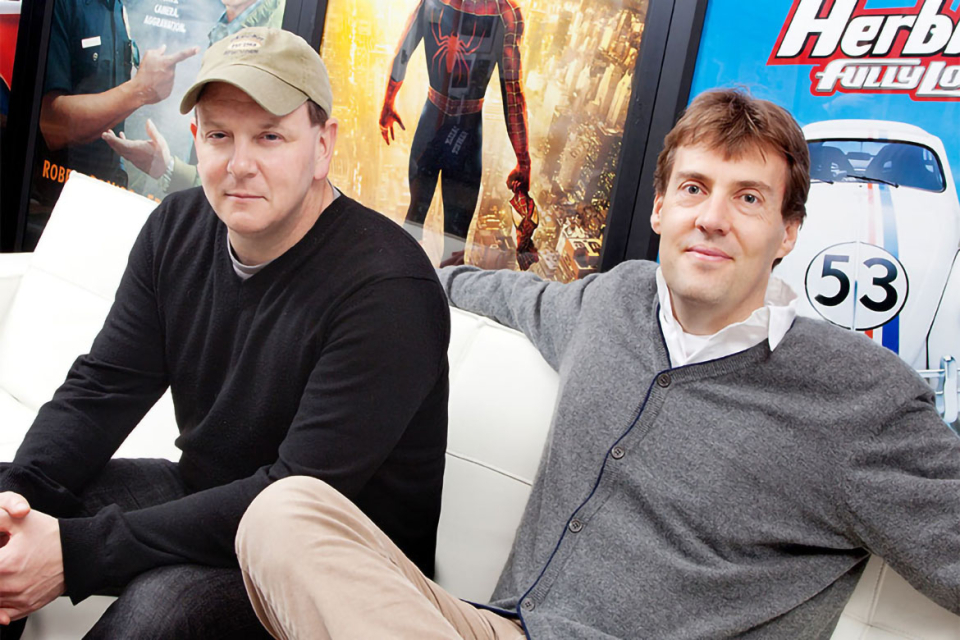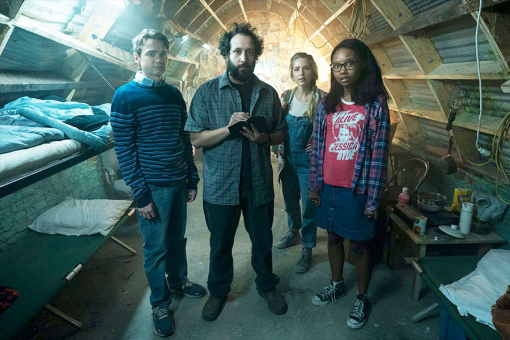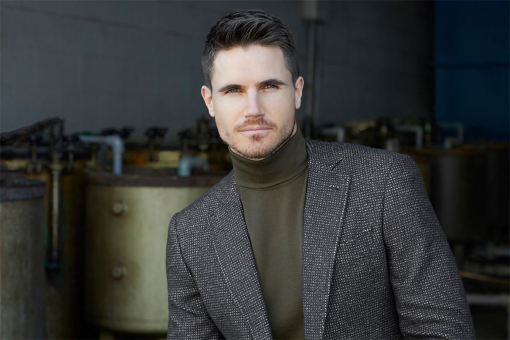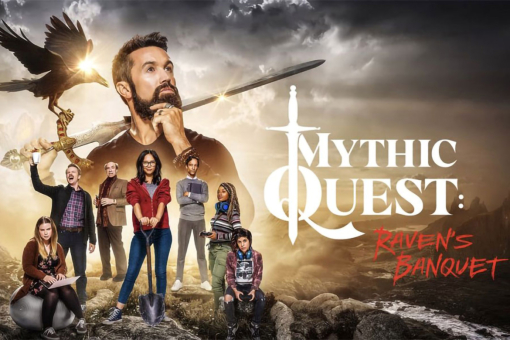One might think a successful partnership of over 20 years might cause a pair of television creatives to coast on past successes.
Al Gough and Miles Millar feel differently and have a longtime habit of breaking convention. The duo redefined a genre as they ushered in the new age of super-hero television shows with Smallville, a series chronicling the adventures of Clark Kent’s formative years.
They now embrace a new challenge in creating a pair of new shows straddling two different genres and three continents.
AMC’s Into the Badlands, Gough and Millar’s “passion project,” follows a warrior and a young boy as they traverse a violent world in a spiritual quest. As its main production wing shoots in Louisiana, Into the Badlands employs a martial arts crew in Hong Kong as a way to authenticate the series’ intricate battle choreography.
Shooting across the world in New Zealand is The Shannara Chronicles, the new MTV series based on Terry Brooks’ line of fantasy novels. The Shannara Chronicles promises to embrace its fantasy elements for its debut in January 2016, while Into the Bandlands beautifully kicks away into its season finale on December 20.
Can you talk about the development of Into the Badlands?
Al Gough: Miles and I have always had a love of martial arts and the genre. The first two films we wrote were Lethal Weapon IV and Shanghai Noon. This was always a passion project for us. We wanted to do it authentically. Having worked with Jet Li and Jackie Chan, and seeing how and what they do, we knew this was something that hadn’t been seen on television.
Our mantra is we write shows where we’d be the first fans – and if we saw it and somebody else had made it, we’d be incredibly jealous and wished we’d done it. When we pitched the show to AMC, we said we were going to need a full-time concurrent fight unit to properly do the martial arts scenes.
Stacy Sher, our other producer on the show, had met [series star] Daniel Wu in Hong Kong. Daniel’s producing partner is Stephen Fung, a well-known Chinese Director. They were our partners from the start and they were there to bring that authentic martial art. To AMC’s credit, they went with it.
It’s not something that’s inexpensive, and it brings a lot of logistical challenges with it. People ask why there aren’t more martial arts shows on television. It’s because they’re really hard to do if you want to do them correctly. It’s not the usual two days of second unit shooting. This fight unit is as large as the main unit in many respects.
What were the challenges in having these two production units?
AG: There are a lot of challenges involved. We brought in [Martial Arts Coordinator] Master “Dee Dee” Ku, who trained under Yuen Woo-Ping, and had worked on The Matrix, Kill Bill, and on Jet Li movies. When you bring that authentic Hong Kong style in, the challenge comes in marrying the drama to the martial arts.
That’s something we had experience doing on the feature side. We fully write out the martial arts sequences. We just don’t just write “and there’s a fight [scene] here.” The martial art scenes are integrated into the story.
The team needs to know the location and the big story points covered in the fight scene, then they bring their unique, special talents to it. It’s a lot like jazz. They’ll come in to a space and get inspired.
We have a great admiration and respect for what they do. They were up to the challenge, wanted to learn, and had a great curiosity about the way American television worked. It’s a great collaboration. Daniel Wu has shown the episodes to his colleagues and they’ve been very impressed with the show’s production value.
Even though it’s an incredibly hard show to make, especially when you’re doing an original series not based on a comic book or graphic novel, and building [the series] as it goes, it’s great to have people react the way they’ve been reacting.
There’s always an expectation that the first season is going to be the most difficult with a unique set of growing pains. What lesson can you apply to future seasons?
AG: There are some sad realities of the production aspect of it. We shot the first season in Louisiana, and while it’s great out there, I think we would have to find a place outside of the United States to shoot where we’d get a little more bang for the buck.
One of the biggest challenges was dealing with the budget and everything we wanted to accomplish. There’s a reason that these world-building shows aren’t shooting [in the United States]. Game of Thrones, Outlander, and Black Sails are all shot in different countries. The American dollar goes farther in other countries and you can put more onscreen.
Certainly in Season One, you’ve got a great glimpse of the Badlands, but we definitely want to open it up and explore more of it. We’d like the flexibility of doing some different things, and you can do that in a place where your money goes further.
Since you’re primarily based in Los Angeles, how are you able to cover productions across two states and three continents? Was all this happening simultaneously?
Miles Millar: We shot The Shannara Chronicles first, then Into the Badlands. We had one show shooting in New Zealand and another in Louisiana. That was a challenge in itself being in two places at once.
Were you splitting your time between locations? Did you divvy up the production responsibilities?
MM: For The Shannara Chronicles, we were in New Zealand for four months of pre-production and the production of the first two episodes. Then we moved to New Orleans and were there for the ground floor for pre-production and the first six episodes of Into the Badlands.
Then we were back for postproduction. Both shows have hundreds of [special effects] shots and we had cuts to get out. It was really incredibly challenging.
MM: The fight unit shot on location in New Orleans. We brought the fight scenes from Hong Kong to New Orleans.
Moving on to The Shannara Chronicles, your show is focusing on the second book of the series. Is this the only book you have the rights to use?
MM: Sonar Entertainment and MTV have the option to the first four books of the series. It was on Terry Brooks’ suggestion that the second book, The Elfstones of Shannara, should be the starting off point for the series.
It’s a show of epic world building, on a bigger scale, with palaces and cities. It’s a fantasy world. The show set on earth thousands of years in the future, with fully evolved societies, creatures, epic action, and much more in the vein of Lord of the Rings than Badlands.
Were you fans of Terry Brooks’ work?
MM: We knew his work but hadn’t read the book. We read it and just fell in love with the story. We thought it was an amazing ride with an incredibly emotional ending. It has a great trio of characters at its core in Wil Ohmsford, Eretria, and Princess Amberle. It’s a world he hadn’t seen before and something missing on television.
Obviously, there will be comparisons to Game of Thrones, but that show is just on the fringes of fantasy. The star of The Shannara Chronicles is half-elf/half-human; there are no elf ears on Game of Thrones. For us it was exciting and different. We hadn’t ventured into fantasy before.
At this point in our lives, we really want to challenge and stretch ourselves, and we had no interest in doing in another super-hero show. So, how do we do something that’s bold and creatively satisfying for us? That’s how [our involvement with the series] happened.
When you were making Smallville, one major series edict was “No flight, no tights.” Do you set limits like that now?
AG: It was specific for Smallville. We sold Smallville 15 years ago. At the time, the last Batman movie was Batman and Robin, and the last Superman [TV show] was Lois & Clark: The New Adventures of Superman. The first Marvel movie that had come out that previous summer was X-Men.
MM: There was skepticism from both the critics and the industry about having a show about Superboy work on television. It was part of that nervousness of that era, the pre-Marvel movie era. Now, it seems impossible to believe that people would feel that way.
How does your writing partnership work? Do you write separately or together?
AG: We write in the same room.
MM: We spend a little time in cafés, talking about the stories and scripts before we write the actual drafts. We have our little haunts around Los Angeles.
When we get into production, we divvy up the jobs. Al’s very good with the budgets, the physical production elements, and dealing with the staffing. I’m more on the visual side, with the production design and costumes.
AG: We compliment each other. The good news is we don’t have the same blind spots.
Do your roles as series producers influence how you approach your writing?
AG: We do put the producer hat on a little bit, but then we throw it off. When you start writing, especially if it’s a new project, you don’t want to start off having your arm tied behind your back that way.
You try to write the best you can write, tell the best story you can tell, and then once you have it, people are excited about it and want to do it and figure out how to make it. I think if you try to do that too soon, you limit yourself.
What piece of advice do you wish someone had given you at the start of your writing careers?
MM: If you do a movie, listen to the director and nobody else. That would have been very good advice for us.
AG: That’s a good one. I think as you grow as a writer you become more confident. Always listen to outside opinions.
The thing that television does is it beats the preciousness out of you. Don’t hold on to ideas. If one idea doesn’t work, let it go, another idea will come. We do that now and it hasn’t failed us.
Have a strong point of view, but be willing to listen to other opinions, and always keep yourself open to a new or better idea.













